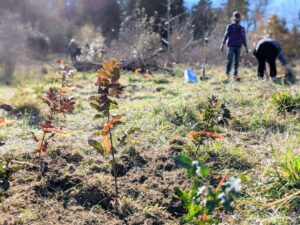Tag: east portland
Wilkes Creek – Connecting a Community
New funding will develop the Wilkes Creek Headwaters into an accessible natural area
For three planting seasons, Friends of Trees volunteers have been enhancing the natural area at the Wilkes Creek Headwaters in outer East Portland. The 20.7-acre hybrid park is nestled in the neighborhood, and provides opportunities for local residents to connect with nature. The site was jointly purchased by Portland Parks & Recreation, the Bureau of Environmental Services, and Metro in 2011, and it will be preserved and enhanced as a public space for generations to come.
The natural area is particularly special because it is home to the headwaters of Wilkes Creek, which flows into the Columbia Slough. Just past the planting site, you can see the natural springs where water comes to the surface and turns into a stream.
“The headwaters can be seen bubbling up from the earth near the midway point of the property,” says Maija Spencer, Senior Community Engagement Coordinator for Portland Parks & Recreation. “Forty bird species, coyotes, and the Stumptown scud—a freshwater crustacean found only in the Portland area—call the property home.”
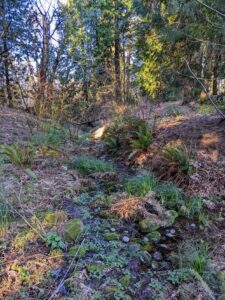
“Wilkes Creek is one of the only remaining free-flowing above-ground streams that makes its way into the Columbia Slough,” says Yoko Silk, a Stewardship Coordinator with PP&R. “There used to be hundreds, now there’s only a handful. So it’s really special for being that source of cold, clean water into the slough. And it provides a really important habitat to all sorts of critters.”
Friends of Trees volunteers have planted native plants throughout the central part of the park as part of the Greening Wilkes Initiative. There’s a wildflower meadow, where they’ve put in thousands of camas, checker mallow, lupine, yarrow, goldenrod, and many more. On the hillside, below an old hazelnut orchard, they have planted shrubs and small-form trees like serviceberry, Oregon grape, snowberry, and oceanspray.
“We want visitors to feel transported,” says Green Space Senior Specialist Harrison Layer. “We’re preserving this natural space as a beacon for birds flying overhead, and wildlife on the ground.”
Wilkes Creek Headwaters has received 8 million dollars in funding for its preservation and development through Portland Parks and Recreation. This park is considered a hybrid space because it’s being enhanced as a natural area at the same time it’s being developed into a usable park with benches, trails, and educational signage. In addition to providing the community with more access to green spaces, developing trails and signage will help protect the natural area that the community has worked so hard to develop.
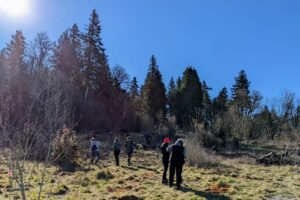
“Portland Parks & Recreation will collaborate with partners and community members to create a plan for developing the park, with a focus on including the voices of Native and Indigenous communities and communities of color,” Maija says. “The goal is to enhance the park’s natural features, while also providing more recreational opportunities and access to nature for East Portland residents.”
“This is an important park because of its location in East Portland, an area that has less park space and opportunities to connect with nature,” Harrison says. “It also shows the connectivity that a creek can bring to a community. It starts at the park, moves through neighborhoods and industrial space, and eventually flows into the slough. Protecting this area will help protect the Columbia Slough as a whole.”
The Greening Wilkes Initiative incorporates a layered approach to community engagement. Community organizations have joined together in the collaborative effort to enhance and diversify green spaces throughout the neighborhood around Wilkes City Park and Wilkes Creek Headwaters in outer East Portland. Friends of Trees, Portland Audubon, Verde, Columbia Slough Watershed Council, and Portland Parks & Recreation each provide their unique and complementary approaches to community engagement around important natural resources in the Wilkes community.
“I’ve had community members tell me that they didn’t even realize that this natural spring was here,” says Harrison Layer, our Green Space Specialist who leads Wilkes Creek plantings. “It’s really special to share it with them.”
You are invited to join in shaping the future of this special place by joining the email list and applying for the project advisory committee. More info can be found here.
An update on our Robert Wood Johnson Foundation partnership
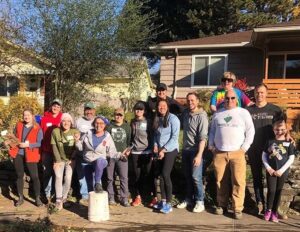
Engaging Community to Take Climate Action
We know that trees fight climate change. And here at Friends of Trees our experience partnering with thousands of community members tells us that the volunteer experience also helps fight climate change – because folks who volunteer to plant and care for trees often go on to become involved with other environmental issues, including taking climate action.
We’re excited to share that through our partnership with the Robert Wood Johnson Foundation, APANO (Asian Pacific American Network of Oregon), Portland State University’s Toulan School of Urban Studies and Planning, OHSU-PSU Joint School of Public Health, and Willamette Partnership, we should soon have quantitative and additional qualitative data to support this. This project recognizes that “where one lives or works, one’s age, if one has pre-existing health conditions or chronic illnesses, and race or income all impacts how and how much climate change harms health.” Friends of Trees’ efforts over the past 20+ years of planting in east Portland and other low-canopy, underserved neighborhoods also recognizes this, and this partnership takes these efforts to the next level, especially around community involvement.
“Engaging with historically marginalized communities about where neighborhood change needs to happen and how it might happen are the first steps to ensuring an equitable urban forestry program.”
– Dr. Vivek Shandas, PSU, School of Urban Studies
A major project milestone is the formation of a community advisory board, facilitated by APANO, and comprised of people who live in, work in, or regularly engage with east Portland’s Jade District. Participants include a Friends of Trees tree recipient, a PSU student, a middle school student, a Rosemary Anderson High School/POIC graduate, a biology educator, and Multnomah County representation. Upcoming CAB activities include a live tree walk in the Jade District, exploring topics such as infrastructure challenges to adding trees (e.g., with so many parking lots, where and how do we plant trees?) and how to address these challenges.
“What’s really exciting about this project is the community advisory board, which isn’t something we usually have the resources to develop.” Michelle Yasutake, Friends of Trees Green Space Program Manager
Michelle’s project role involves a major project milestone, the formation of a community advisory board, facilitated by APANO, and comprised of people who live in, work in, or regularly engage with east Portland’s Jade District. Dr. Shandas is also a strong supporter of direct community involvement, “By integrating community voices with our technical know-how, this project is identifying ‘nature-based solutions’ in areas that have been neglected and disinvested by regional decision makers.”
Friends of Trees wants to do even more to engage people in the community in project planning and prioritizing, and we know that the best way to achieve diverse and authentic representation is to be able to provide stipends in consideration of the time it takes people to participate. The Robert Wood Johnson Foundation recognizes the value of this and its grant includes funding for these stipends. Michelle further emphasizes the importance of community involvement,
“This project, and the community advisory board, are so important to Friends of Trees’ goals around equity, diversity and inclusion and our efforts to genuinely work with the people who actually live and work in the community, and to do so in a way that ensures community members feel like they are truly a part of the process.”
Next steps in the project include data collection through surveying the community; we’re asking questions about neighborhood involvement, civic engagement such as voting, the impact of COVID on household income, and more. We’ll also take on a tangible project such as adding green infrastructure (trees, bioswales, shrubs) to a site identified as a priority by the community; and we’ll be using a research tool called Photovoice.
Photovoice is a hands-on, photography-based research method designed to help community members identify and discuss important community issues and take social action. Photovoice involves using cameras/smartphones to visually document, describe, and discuss important community concerns.
For this Photovoice project, adult and youth community residents will use photography and digital mapping to collaboratively identify and map out important climate, greenspace, and community health concerns—centering the perspectives of residents of East Portland and the Jade District. This will include identifying specific places and spaces that represent important locations of daily climate and greenspace experiences. The goal is to create new local climate and community health data that prioritizes community lived experience and knowledge, such that the data can be used to respond to specific community concerns.
The purpose of this partnership is to “Examine the physical and social dimensions of a tree planting program as a strategy to improve public health and mitigate climate change.” East Portland is one of seven communities across the country where RWJF is studying health, health equity and climate change solutions through its Culture of Health Action Framework, marking RWJF’s first foray into climate health solutions. As this project progresses we’ll share more milestones and updates, so stay tuned!
Photo at top: Friends of Trees East Portland tree planting event, November 2019.
David Douglas students shine for Friends of Trees
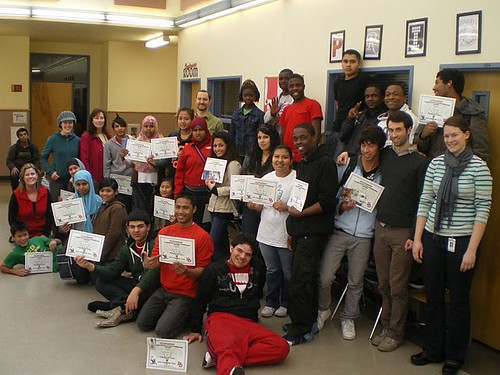
By Andrew Land
Friends of Trees and students of David Douglas High School‘s English as a Second Language program continued to strengthen their bond during an awards ceremony yesterday afternoon. Kate Farrington of our Neighborhood Trees staff and I had the privilege of acknowledging the energy and enthusiasm these fine students (and their teachers) have added to three separate plantings this season.
As a group, they first attended our January 15th Lents and Powellhurst-Gilbert planting, where their presence had a palpably positive effect on several planting crews. They enjoyed the experience so much that David Douglas staff members Anne Downing and Tyler Greene reached out to us and offered their support again for our January 29th Centennial, Mill Park, and Hazelwood planting.
Following that planting, we knew that a symbiotic relationship was brewing and invited them to help us one more time at our March 12th Argay, Parkrose, Parkrose Heights, Russell, Sumner, and Wilkes planting. Their presence was a particularly huge boon at that event given that we were short-handed there last year. We were thrilled to have far better human resources this season, and their group represented nearly one-third of the entire volunteer planting force that day.
The beauty of our recently-forged bond is that both Friends of Trees and David Douglas’ students and staff view one another with admiration. Although students and staff alike mentioned to me yesterday that they have loved coming to our plantings, we have been just as thankful that they are as supportive and dependable as they are, particularly since many are recent immigrants in need of help during their adjustment to life in a new country.
Representing such countries as Somalia, Burma, and The Congo, many come from refugee families with very limited resources. They have been excellent ambassadors for their cultures who are already giving back to their new community. While they appreciate the opportunity to bond outside of the classroom, we have sincerely appreciated the service they are providing generations of Portlanders to come.
It will be a beautiful day when one among them is walking around this city with their own children and can point to a tall tree they planted as a teenager. We are so fortunate to have both newly transplanted trees and the support of David Douglas’ newly transplanted students. May they grow to thrive side by side!
— Land is Volunteer & Outreach Specialist for Friends of Trees.

